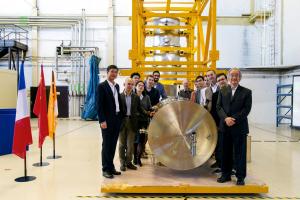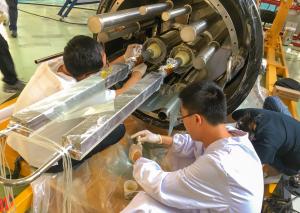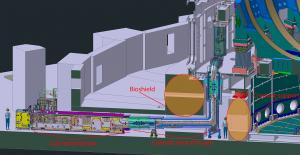At MIFI, the cryostat feedthrough will be subjected to high-voltage tests, leak tests and endoscopic inspections before being installed into the Tokamak assembly arena and later connected to poloidal field coil #4, one of the two largest of the machine's six poloidal field coils (24 metres in diameter).
To celebrate this highly symbolic event, representatives from CEA's Research Institute for Magnetic Fusion (IRFM), MIFI and the Chinese Domestic Agency joined ITER management and staff from the Magnets Division inside the MIFI hall, in the presence of the massive component.
"The arrival of this component is in itself a cause for celebration," said ITER Director-General Bernard Bigot. "It is the very first in a long line of magnet system elements for the most complex, most challenging electromagnetic device ever designed—the ITER Tokamak."
For Luo Dulong, head of ITER China, the moment—ten years, almost to the day, after
the official establishment of the ITER Organization—will be "recognized as historical."
"MIFI is the most visible element of our cooperation with ITER in the field of superconducting magnets, and this component is the most spectacular among those that will be tested in this workshop," said Alain Bécoulet, the head of IRFM. "But it is only a beginning. As more magnet components are delivered to ITER in the coming weeks and months our collaboration with increase and expand."




